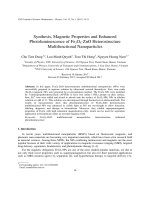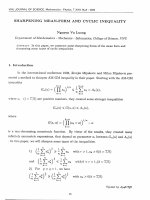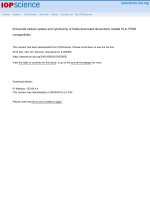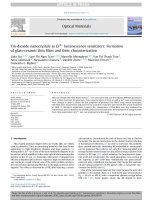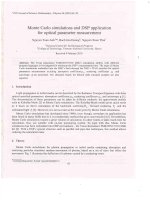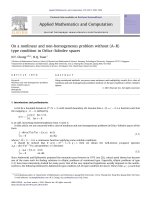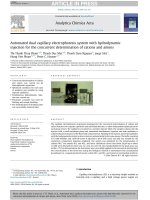DSpace at VNU: Convolutions, integral transforms and integral equations by means of the theory of reproducing kernels
Bạn đang xem bản rút gọn của tài liệu. Xem và tải ngay bản đầy đủ của tài liệu tại đây (625.76 KB, 14 trang )
Opuscula Mathematica • Vol. 32 • No. 4 • 2012
/>
Dedicated to Professor Semyon Yakubovich on the occasion of his 50th birthday
CONVOLUTIONS, INTEGRAL TRANSFORMS
AND INTEGRAL EQUATIONS
BY MEANS OF THE THEORY
OF REPRODUCING KERNELS
Luis P. Castro, Saburou Saitoh, and Nguyen Minh Tuan
Abstract. This paper introduces a general concept of convolutions by means of the theory
of reproducing kernels which turns out to be useful for several concrete examples and applications. Consequent properties are exposed (including, in particular, associated norm inequalities).
Keywords: Hilbert space, linear transform, reproducing kernel, linear mapping, convolution,
norm inequality, integral equation, Tikhonov regularization.
Mathematics Subject Classification: 30C40, 42A85, 45E10, 44A20, 46H05.
1. PRELIMINARIES
Following [25, 30] and [3], we shall introduce a general theory for linear mappings in
the framework of Hilbert spaces.
Let H be a Hilbert (possibly finite-dimensional) space. Let E be an abstract set and
h be a Hilbert H-valued function on E. Then we shall consider the linear transform
f (p) = (f , h(p))H ,
f ∈ H,
(1.1)
from H into the linear space F(E) comprising all the complex valued functions on E.
In order to investigate the linear mapping (1.1), we form a positive definite quadratic
form function K(p, q) on E defined by
K(p, q) = (h(q), h(p))H on E×E.
Then, we obtain the following:
(P1) The range of the linear mapping (1.1) by H is characterized as the reproducing
kernel Hilbert space (RKHS ) HK (E) admitting the reproducing kernel K(p, q)
633
634
Luis P. Castro, Saburou Saitoh, and Nguyen Minh Tuan
whose characterization is given by the two following properties: K(·, q) ∈ HK (E)
for any q ∈ E and, for any f ∈ HK (E) and for any p ∈ E, (f (·), K(·.p))HK (E) =
f (p).
(P2) In general, we have the inequality f HK (E) ≤ f H . Here, for any member f
of HK (E) there exists a uniquely determined f ∗ ∈ H satisfying
f (p) = (f ∗ , h(p))H on E
and
f
HK (E)
= f∗
H.
(P3) In general, we have the inversion formula in (1.1) in the form
f → f∗
(1.2)
in (P2) by using the reproducing kernel Hilbert space HK (E).
However, this formula (1.2) is – in general – involved and consequently we need
new arguments for each case. If we are in the case where the Hilbert space H itself
is a reproducing kernel Hilbert space, then we can apply the Tikhonov regularization
method in order to obtain the inversion numerically and, sometimes, analytically –
as we shall see later. In this paper, we are assuming that the inversion formula (1.2)
may be, in general, established.
Now we shall consider two systems
fj (p) = (fj , hj (p))Hj , fj ∈ Hj ,
in the above way by using {Hj , E, hj }2j=1 . Here, we assume that E is the same set for
the two systems in order to have the output functions f1 (p) and f2 (p) on the same
set E.
For example, we shall consider the operator f1 (p)f2 (p) in F(E). Then, we can
consider the following problem:
How to represent the product f1 (p)f2 (p) on E in terms of their inputs f1 and
f2 through one system?
We shall show that by using the theory of reproducing kernels we can give a natural
answer for this problem. Following similar ideas, we can consider various operators
among Hilbert spaces. See [4] for consequent details. In particular, for the product
of two Hilbert spaces, the idea gives generalizations of convolutions and the related
natural convolution norm inequalities. These norm inequalities gave various generalizations and applications to forward and inverse problems for linear partial differential
equations, see for example, [4,6–8,19–29]. Furthermore, surprisingly enough, for some
very general nonlinear systems, we can consider similar problems (see [26] for details).
Here, for its importance, we shall consider the product case which will give a general
concept of convolutions and we shall refer to applications to integral equations.
635
Convolutions, integral transforms and integral equations. . .
2. PRODUCT AND CONVOLUTION
2.1. GENERAL THEORY
We start by observing that for any two positive definite quadratic form functions
K1 (p, q) and K2 (p, q) on E, the usual product K(p, q) = K1 (p, q)K2 (p, q) is again a
positive definite quadratic form function on E by Schur’s theorem. Then the reproducing kernel Hilbert space HK admitting the kernel K(p, q) is the restriction of the
tensor product HK1 (E) ⊗ HK2 (E) to the diagonal set; that is given by the following
proposition.
(1)
(2)
Proposition 2.1. Let {fj }j and {fj }j be some complete orthonormal systems in
HK1 (E) and HK2 (E), respectively. Then, the reproducing kernel Hilbert space HK is
comprised of all functions on E which are represented as
(1)
f (p) =
(2)
αi,j fi (p)fj (p)
on
|αi,j |2 < ∞,
E,
i,j
(2.1)
i,j
in the sense of absolutely convergence on E, and its norm in HK is given by
f
2
HK
|αi,j |2 .
= min
i,j
By (P1), for Kj (p, q) = (hj (q), hj (p))Hj on E×E, and for f1 ∈ HK1 (E) and
f2 ∈ HK2 (E), we note that for the reproducing kernel Hilbert space HK1 K2 (E) admitting the reproducing kernel K1 (p, q)K2 (p, q) on E, in general, we have the inequality
f1 f2 HK1 K2 (E) ≤ f1 HK1 (E) f2 HK2 (E) .
For the positive definite quadratic form function K1 K2 on E, we assume an expression of the form
K1 (p, q)K2 (p, q) = (hP (q), hP (p))HP on E × E
(2.2)
with a Hilbert space HP -valued function hP (p) on E and further we assume that
{hP (p) : p ∈ E} is complete in HP .
(2.3)
Such a representation is, in general, possible by the fundamental result of Kolmogorov.
Then we can consider conversely the linear mapping from HP onto HK1 K2 (E),
fP (p) = (fP , hP (p))HP , fP ∈ HP , and we obtain the isometric identity
fP
HK1 K2 (E)
= fP
HP .
Hence, for such representations (2.2) with (2.3), we obtain the isometric mapping
between the Hilbert spaces HP and HK1 K2 (E).
Now, for the product f1 (p)f2 (p) there exists a uniquely determined fP ∈ HP
satisfying
f1 (p)f2 (p) = (fP , hP (p))HP on E.
636
Luis P. Castro, Saburou Saitoh, and Nguyen Minh Tuan
Then, fP may be considered as a product of f1 and f2 through these transforms and
so, we shall introduce the notation
fS = f1 [×]f2 .
For the members f1 ∈ H1 and f2 ∈ H2 , this product is introduced through the three
transforms induced by {Hj , E, hj } (j = 1, 2) and {HP , E, hP }.
The operator f1 [×]f2 is expressible in terms of f1 and f2 by the inversion formula
(f1 , h1 (p))H1 (f2 , h2 (p))H2 → f1 [×]f2
in the sense (P2) from HK1 K2 (E) onto HP . Then, from (P2) and (2.3) we have the
following Schwarz type inequality.
Proposition 2.2. We have the inequality
f1 [×]f2
HP
≤ f1
H1
f2
H2 .
If {hj (p) : p ∈ E} are complete in Hj (j = 1, 2), then Hj and HKj are isometrical. By using the isometric mappings induced by the Hilbert space valued functions
hj (j = 1, 2) and hP , we can introduce the product space of H1 and H2 in the form
H1 [×]H2
through these transforms.
We can also obtain the corresponding sum version.
Proposition 2.3. For two positive definite quadratic form functions K1 (p, q) and
K2 (p, q) on E, the sum KS (p, q) = K1 (p, q) + K2 (p, q) is a positive definite quadratic
form function on E. The RKHS HKS admitting the reproducing kernel KS (p, q) on
E is composed of all functions
f = f1 + f2
(fj ∈ HKj (E))
(2.4)
and the norm in HKS is given by
f
2
HKS
= min{ f1
2
HK1 (E)
+ f2
2
HK2 (E) },
where the minimum is taken over all the expressions (2.4) for f . In particular, we
obtain the triangle inequality
f1 + f2
2
HS
≤ f1
2
HK1 (E)
+ f2
2
HK2 (E)
(2.5)
for fj ∈ KKj (E) for j = 1, 2.
For the positive definite quadratic form function K1 + K2 on E, we assume the
expression in the form
K1 (p, q) + K2 (p, q) = (hS (q), hS (p))HS on E × E
637
Convolutions, integral transforms and integral equations. . .
with a Hilbert space HS -valued function hS (p) on E and further we assume that
{hS (p) : p ∈ E} is complete in HS .
Such a representation is, in general, possible by the fundamental result of Kolmogorov.
Then, we can consider conversely the linear mapping from HS onto HK1 +K2 (E)
fS (p) = (fS , hS (p))HS , fS ∈ HS
(2.6)
and we obtain the isometric identity
fS
HK1 +K2 (E)
= fS
HS .
(2.7)
Hence, for such representations (2.6) with (2.7), we obtain the isometric mapping
between the Hilbert spaces HS and HK1 +K2 (E).
Now, for the sum f1 (p) + f2 (p) there exists a uniquely determined fS ∈ HP satisfying
f1 (p) + f2 (p) = (fS , hS (p))HS on E.
Then, fS may be considered as a sum of f1 and f2 through these transforms and so,
we shall introduce the notation
fS = f1 [+]f2 .
This sum for the members f1 ∈ H1 and f2 ∈ H2 is introduced through the three
transforms induced by {Hj , E, hj } (j = 1, 2) and {HS , E, hS }.
The operator f1 [+]f2 is expressible in terms of f1 and f2 by the inversion formula
(f1 , h1 (p))H1 + (f2 , h2 (p))H2 −→ f1 [+]f2
in the sense (P2) from HK1 +K2 (E) onto HS . Then, from (P2) and (2.5) we have the
following triangle inequality.
Proposition 2.4. We have the inequality
f1 [+]f2
2
HS
≤ f1
2
H1
+ f2
2
H2 .
If {hj (p) : p ∈ E} are complete in Hj (j = 1, 2), then Hj and HKj (E) are isometrical. By using the isometric mappings induced by the Hilbert space valued functions
hj (j = 1, 2) and hS , we can introduce the sum space of H1 and H2 in the form
H1 [+]H2
through these transforms.
2.2. EXAMPLE
In order to see the typical example for the operators F1 [×]F2 , by non-negative integrable functions ρj , not zero identically, we shall consider the following reproducing
kernels and the integral transforms. For j = 1, 2, we define Kj by
Kj (x, y) =
1
2π
exp(i(x − y) · t)ρj (t) dt.
R
638
Luis P. Castro, Saburou Saitoh, and Nguyen Minh Tuan
We now consider the induced integral transforms Lj : L2 (R; ρj ) → HKj by
1
2π
(Lj F )(t) =
F (x)ρj (x) exp(−it · x) dx.
R
Then, for the reproducing kernel Hilbert space HKj admitting the kernel Kj , we have
the isometric identities:
2
HKj
fj
=
1
2π
|Fj (t)|2 ρj (t)dt,
(2.8)
R
respectively. It follows from the Fubini theorem that
1
(2π)2
K1 (x, y)K2 (x, y) =
exp(i(x − y) · t)(ρ1 ∗ ρ2 )(t) dt.
R
The same can be said for L1 F1 · L2 F2 as follows:
(L1 F1 )(x)(L2 F2 )(x) =
1
(2π)2
exp(−ix · t)(F1 ρ1 ) ∗ (F2 ρ2 )(t) dt.
R
By the property of the product kernel space HK1 K2 , we have
L1 F1 · L2 F2
≤ L1 F1
HK1 K2
HK1
· L2 F2
HK2 .
If we write out in full both sides, we obtain the next result.
Proposition 2.5. Let ρ1 , ρ2 be two non-negative integrable functions that are not
zero identically, on R. If F1 , F2 : R → [0, ∞] are measurable functions, then we have
R
1
(ρ1 ∗ ρ2 )(t)
2
F1 (ξ)ρ1 (ξ)F2 (t − ξ)ρ2 (t − ξ) dξ
dt ≤
R
|F1 (t)|2 ρ1 (t)dt ·
≤
R
|F2 (t)|2 ρ2 (t) dt.
(2.9)
R
In this case, we have the explicit representation
(F1 [×]F2 )(t) =
((F1 ρ1 ) ∗ (F2 ρ2 ))(t)
.
(ρ1 ∗ ρ2 )(t)
Similarly, for the sum case, we have
(F1 [+]F2 )(t) =
F1 (t)ρ1 (t) + F2 (t)ρ2 (t)
.
ρ1 (t) + ρ2 (t)
So, in the weighted Fourier transform case, our new product and sum mean the
weighted convolution and sum.
Proposition 2.5 was expanded in various directions with applications to inverse
problems and partial differential equations through Lp (p > 1) versions and converse
inequalities. See, for example, [6–8, 19–29].
639
Convolutions, integral transforms and integral equations. . .
2.3. APPLICATION TO INTEGRAL EQUATIONS
We shall assume that the above linear transforms
Lj : Hj
fj −→ fj ∈ HKj (E)
and
L : HP
fP −→ fP ∈ HK1 K2 (E)
are isometrical. Within this framework, we are now going to consider the integral
equation
(1)
(2)
f1 [×]f2 + f1 [×]f2 = g
(2.10)
(1)
(2)
for f1 ∈ H1 , f2 , f2 ∈ H2 and g ∈ HP .
At this point, the reader may recall the Fredholm integral equations of the second
kind, as a prototype example. Then, by taking the transform L, we obtain
(1)
L1 f1 (L2 f2
(2)
+ L2 f2 ) = g(p),
and so
(1)
(2)
f1 (p) f2 (p) + f2 (p) = g(p)
(1)
(2.11)
(2)
on the functions on E. Then, for given f2 , f2 ∈ H2 and g ∈ HP , when we solve
the equation, we wish to be able to consider the following representation in some
reasonable mathematical sense:
f1 = L−1
1
g(p)
(1)
f2 (p)
(2)
.
+ f2 (p)
Here, the essential problem, however, rises in the solvability question. Namely, how
to obtain the solution of the equation (2.11)
g(p)
(1)
f2 (p)
(2)
.
+ f2 (p)
This important problem may be solved effectively by using the Tikhonov regularization.
3. TIKHONOV REGULARIZATION
3.1. GENERAL FRAMEWORK
Let E be an arbitrary set, and let HK be a reproducing kernel Hilbert space admitting
the reproducing kernel K(p, q) on E. For any Hilbert space H we consider a bounded
640
Luis P. Castro, Saburou Saitoh, and Nguyen Minh Tuan
linear operator L from HK into H. In general, in order to solve the operator equation
Lf = d, we would be interested in the best approximation problem of finding
inf
f ∈HK
Lf − d
(3.1)
H
for a vector d in H. This problem, itself, leads to the concept of the Moore-Penrose
generalized inverse and by using the theory of reproducing kernels, the theory is
well-formulated, see [25, 30]. However, the just mentioned extremal problem is complicated in many senses. So, we shall consider the Tikhonov regularization within our
framework.
We set, for a small λ > 0,
KL (·, p; λ) =
1
K(·, p),
L∗ L + λI
where L∗ denotes the adjoint operator of L. Then, by introducing the inner product
(f, g)HK (L;λ) = λ(f, g)HK + (Lf, Lg)H , we construct the Hilbert space HK (L; λ) comprising all the functions of HK . This space, of course, admits a reproducing kernel.
Furthermore, we directly obtain the following result proposition.
Proposition 3.1. The extremal function fd,λ (p) in the Tikhonov regularization
inf {λ f
f ∈HK
2
HK
+ d − Lf
2
H}
exists. Additionally, there is a unique element for which the corresponding minimum
is attained and it is represented in terms of the kernel KL (p, q; λ) as follows:
fd,λ (p) = (d, LKL (·, p; λ))H .
(3.2)
Here, the kernel KL (p, q; λ) is the reproducing kernel for the Hilbert space HK (L; λ)
and it is determined as the unique solution K(p, q; λ) of the equation
K(p, q; λ) +
1
1
(LKq , LKp )H = K(p, q)
λ
λ
with Kq = K(·, q; λ) ∈ HK for q ∈ E and Kp = K(·, p) ∈ HK for p ∈ E.
The next proposition gives the inversion for errorness data.
Proposition 3.2. Suppose that λ : (0, 1) → (0, ∞) is a function of δ such that
lim λ(δ) +
δ↓0
δ2
λ(δ)
= 0.
Let D : (0, 1) → H be a function such that D(δ) − d H ≤ δ for all δ ∈ (0, 1). If d is
contained in the range set of the Moore-Penrose inverse, then limδ↓0 fD(δ),λ(δ) = fd .
When d contains error or noise we need its error estimate. For this error estimate,
we are able to invoke the next general result.
641
Convolutions, integral transforms and integral equations. . .
Proposition 3.3 ([3]). We have
1
|fd,λ (p)| ≤ √
2λ
K(p, p) d
H.
3.2. SOLUTIONS OF INTEGRAL EQUATIONS
(1)
(2)
Now we shall consider the linear mapping from HK1 (E), for fixed f2 , f2
(1)
∈ HK2 (E),
(2)
ϕ(f1 ) = f1 (p) f2 (p) + f2 (p)
into HK1 K2 (E). Note that this mapping ϕ is bounded. Indeed,
ϕ(f1 )
2
HK1 K2 (E)
≤ f1
2
HK1 (E)
(1) 2
HK2 (E)
f2
(2) 2
HK2 (E)
+ f2
.
So, we can consider the Tikhonov functional:
inf
f1 ∈HK1 (E)
λ f1
2
HK1 (E)
+ g − ϕ(f1 )
2
HK1 K2 (E)
.
The extremal function f1,λ exists uniquely and we have, if (2.10) has the
Moore-Penrose generalized inverse f1 (p), limλ→0 f1,λ (p) = f1 (p) on E uniformly where
K1 (p, p) is bounded. Furthermore, its convergence is also in the sense of the norm of
HK1 (E). Sometimes we can take λ = 0 and in this case we can represent the solution
in some direct form.
In order to use the representation (3.2), by setting H(p, q; λ) = L1 KL1 (p, q, λ)
that is needed in (3.2) for the representation of the approximate fractional functions,
we have the functional equation
λH(p, q; λ) + (H(·, q; λ), L1 K1 (·, p))HK1 K2 = L1 K1 (p, q).
(3.3)
In the very difficult case of the numerical and real inversion formula of the Laplace
transform, in some cases of (3.3), Fujiwara gave solutions with λ = 10−400 and 600
digits precision. So, in this method, we will be able to give the approximate fractional
functions by using Proposition 3.2 and (3.3), numerically, for many cases containing
the present situation.
In [4], we examined the details for the solutions of (2.11) in the very general
situation of Fourier Analysis. The equation is depending on the function f2 and so,
the problem is very difficult. Due to this fact, the method in the image identification in
the sense of (P1)–(P3) is almost impossible. However, surprisingly enough, solutions
in the sense of the Moore-Penrose generalized inverses in correspondence with (3.1), in
the framework of reproducing kernel Hilbert spaces, can be represented analytically
and explicitly by using Fourier integrals. That will mean, of course, the intuitive
solutions of the equation can be represented analytically and, similarly, when the
solutions exist in (2.11).
642
Luis P. Castro, Saburou Saitoh, and Nguyen Minh Tuan
4. GENERAL INTEGRAL EQUATIONS
First, we recall a prototype example: The integral equation with the mixed
Toeplitz-Hankel kernel is as follows:
k1 (x − y) + k2 (x + y) ϕ(y)dy = f (x),
λϕ(x) +
(4.1)
E
where k1 , k2 are called the Toeplitz, Hankel kernel respectively, and the domain E is
one of the following: the finite interval E = (0, a), half of axis E = (0, +∞), or whole
space E = (−∞, +∞). Unless the case E = (−∞, +∞), the domain of k1 and that of
k2 are not identical; for example, in case E = (0, a), the domain of k1 is (−a, a) and
that of k2 is (0, 2a).
Equation (4.1) was posed a long time ago, and it is an interesting subject in
the theory of integral equations as it has many applications. Actually, this equation
has interested mathematicians, and is still an open problem in general cases (see
[1, 2, 5, 9, 17, 31, 33]).
In order to consider the integral equation (4.1), we set
Ω(t; ρ) = ρ1 ∗ (2π + ρ2 ) +
ρ1 (ξ − t)ρ3 (ξ)dξ.
R
We consider the integral transforms and the kernels for j = 1, 2, 3 in § 2.2.
Now, we shall consider the algebraic equation, with the non-linear operator ϕf2 ,f3
equation, from HK1 , for fixed fj ∈ HKj (j = 2, 3)
(ϕf2 ,f3 (f1 ))(x) = αf1 (x) + f1 (x)f2 (x) + f1 (x)f3 (x) = g(x)
(4.2)
for a function g of a function space that is determined naturally as the image space
of the operator ϕf2 ,f3 . Then, we obtain the identity
1
exp(ix · t) ·
(2π)2 R
·((F1 ρ1 ) ∗ (2πα + (F2 ρ2 )) + ((F1 ρ1 ) ∗ ∗(F3 ρ3 )))(t) dt,
(ϕf2 ,f3 (F1 ))(x) =
for
((F1 ρ1 ) ∗ ∗(F3 ρ3 ))(t) =
F1 (ξ)ρ1 (ξ)F3 (t + ξ)ρ3 (t + ξ)dξ.
R
Here, we must assume that F1 are real valued functions, otherwise, here, we must
put the complex conjugate. Then, the integral transform (4.2) is non-linear for F1
functions. Following the operator ϕf2 ,f3 , we shall consider the identity
K(x, y)
:= K1 (x, y) + K1 (x, y)K2 (x, y) + K1 (x, y)K3 (x, y) =
1
=
exp(i(x − y) · t) · Ω(t; ρ) dt.
(2π)2 R
(4.3)
643
Convolutions, integral transforms and integral equations. . .
Then, by the structure of the reproducing kernel Hilbert spaces of sum and product,
we see that the image g of the nonlinear operator ϕf2 ,f3 belongs to the reproducing
kernel Hilbert space HK defined by (4.3) and furthermore, we obtain the inequality
g
2
HK
2
HK1
≤ f1
|α|2 + f2
2
HK2
2
HK3
+ f3
;
(4.4)
meanwhile, in the t space, we obtain the convolution inequality
R
1
Ω(t; ρ)
2
(F1 ρ1 ) ∗ (2πα + (F2 ρ2 ) + (F1 ρ1 ) ∗ ∗(F3 ρ3 )
|F1 (t)|2 ρ1 (t) dt · 2π|α|2 +
≤
|F2 (t)|2 ρ2 (t) dt +
R
R
(t)
dt ≤
|F3 (t)|2 ρ3 (t) dt .
(4.5)
R
Now, we wish to solve the convolution equation of the type
˜
((F1 ρ1 ) ∗ (2πα + (F2 ρ2 )) + (F1 ρ1 ) ∗ ∗(F3 ρ3 ))(t) = G(t),
(4.6)
that is the form (4.1), by setting Fj ρj = Fj and that was transformed to the algebraic
equation (4.6).
The fundamental inequality (4.5) means that the operator ϕf2 ,f2 is bounded on
HK1 into the space HK , however the mapping is nonlinear. We need a bounded
linear operator from some reproducing kernel Hilbert space into a Hilbert space for
applying Proposition 2.3. In order to introduce a suitable reproducing kernel Hilbert
space, we shall assume that ρ1 is positive continuous on the support [a, b] of ρ1 with
−∞ ≤ a < b ≤ +∞. In particular, note that F1 ∈ L1 (a, b). We shall consider the
reproducing kernel Hilbert space HKρ1 . We define the positive definite quadratic form
function
min(t,τ )
1
dξ.
Kρ1 (t, τ ) =
ρ1 (ξ)
a
Then the reproducing kernel Hilbert space HKρ1 is composed of functions f , absolutely
continuous, f (a) = 0 with the inner product
b
(f1 , f2 )HKρ =
1
f1 (t)f2 (t)ρ1 (t)dt,
a
as we see directly ([25]). Then, we see that for F1 satisfying (3.3), when we set
t
fρ1 (t) =
F1 (ξ)dξ,
a
we obtain the isometric identity
fρ1
2
HKρ
1
|F1 (t)|2 ρ1 (t)dt =
=
R
1
f1
2π
2
HK1 ,
644
Luis P. Castro, Saburou Saitoh, and Nguyen Minh Tuan
in (3.3). When we consider the operator (4.6) from this reproducing kernel Hilbert
space HKρ1 into the Hilbert space L2 (Ωρ ) comprising the functions F with norm
squares
1
1
|F (t)|2
dt < ∞,
(2π)2
Ω(t; ρ)
R
it is a bounded linear operator as we see from (4.5).
For some general integral equations (4.1) we can write down solutions of (4.1)
with long arguments and calculations. However, its representation is involved and so
the Tikhonov regularization method would be suitable and practical.
Acknowledgments
This work was supported in part by Center for Research and Development in Mathematics and Applications of the University of Aveiro, and the Portuguese Science
Foundation (FCT–Fundação para a Ciência e a Tecnologia). The second author was
also supported in part by the Grant-in-Aid for the Scientific Research (C )(2 )(No.
21540111 ) from the Japanese Society for the Promotion Science.
REFERENCES
[1] B.D.O. Anderson, T. Kailath, Fast algorithms for the integral equations of the inverse
scattering problem, Integral Equations Operator Theory 1 (1978) 1, 132–136.
[2] G.B. Arfken, H.J. Weber, Mathematical Methods for Physicists, 5th ed., Harcourt/Academic Press, Burlington, MA, 2001.
[3] L.P. Castro, S. Saitoh, Y. Sawano, A.M. Simões, General inhomogeneous discrete linear
partial differential equations with constant coefficients on the whole spaces, Complex
Anal. Oper. Theory 6 (2012) 1, 307–324.
[4] L.P. Castro, S. Saitoh, Fractional functions and their representations, Complex Anal.
Oper. Theory, DOI: 10.1007/s11785-011-0554-1, 15 pp.
[5] K. Chadan, P.C. Sabatier, Inverse Problems in Quantum Scattering Theory. 2nd ed.,
Texts and Monographs in Physics. Springer-Verlag, New York, 1989.
[6] D.T. Duc, N.D.V. Nhan, On some convolution norm inequalities in weighted Lp (Rn , ρ)
spaces and their applications, Math. Inequal. Appl. 11 (2008) 3, 495–505.
[7] D.T. Duc, N.D.V. Nhan, On some reverse weighted Lp (Rn )-norm inequalities in convolutions and their applications, Math. Inequal. Appl. 12 (2009) 1, 67–80.
[8] D.T. Duc, N.D.V. Nhan, Some applications of convolution inequalities in weighted Lp
spaces, Integral Transforms Spec. Funct. 19 (2008) 7–8, 471–480.
[9] I. Feldman, I. Gohberg, N. Krupnik, Convolution equations on finite intervals and factorization of matrix functions, Integral Equation Operator Theory 36 (2000), 201–211.
Convolutions, integral transforms and integral equations. . .
645
[10] H. Fujiwara, High-accurate numerical method for integral equation of the first kind under multiple-precision arithmetic, Theoretical and Applied Mechanics Japan 52 (2003),
192–203.
[11] H. Fujiwara, T. Matsuura, S. Saitoh, Y. Sawano, Numerical real inversion of the Laplace
transform by using a high-accuracy numerical method, Further Progress in Analysis,
World Sci. Publ., Hackensack, NJ, 2009, 574–583.
[12] H. Fujiwara, Numerical real inversion of the Laplace transform by reproducing kernel
and multiple-precision arithmetric, Progress in Analysis and its Applications, Proceedings of the 7th International ISAAC Congress, World Scientific, 2010, 289–295.
[13] B.T. Giang, N.V. Mau, N.M. Tuan, Operational properties of two integral transforms
of Fourier type and their convolutions, Integral Equations Operator Theory 65 (2009)
3, 363–386.
[14] B.T. Giang, N.V. Mau, N.M. Tuan, Convolutions for the Fourier transforms with geometric variables and applications, Math. Nachr. 283 (2010), 1758–1770.
[15] B.T. Giang, N.M. Tuan, Generalized convolutions for the Fourier integral transforms
and applications, Journal of Siberian Federal Univ. 1 (2008) 4, 371–379.
[16] H. Hochstadt, Integral Equations, John Wiley & Sons, N.Y., 1973.
[17] T. Kailath, Some integral equations with “nonrational” kernels, IEEE Trans. Information
Theory IT-12 (1966) 442–447.
[18] V.A. Kakichev, On the convolution for integral transforms, Izv. ANBSSR, Ser. Fiz. Mat.
2 (1967) 2, 48–57 (in Russian).
[19] N.D.V. Nhan, D.T. Duc, V.K. Tuan, Reverse weighted Lp -norm inequalities for convolution type integrals, Armen. J. Math. 2 (2009) 3, 77–93.
[20] N.D.V. Nhan, D.T. Duc, Fundamental iterated convolution inequalities in weighted Lp
spaces and their applications, Math. Inequal. Appl. 12 (2009) 3, 487–498.
[21] N.D.V. Nhan, D.T. Duc, V.K. Tuan, Weighted Lp -norm inequalities for various convolution type transformations and their applications, Armen. J. Math. 1 (2008) 4, 1–18.
[22] N.D.V. Nhan, D.T. Duc, Fundamental inequalities for the iterated Laplace convolution
in weighted Lp spaces and their applications, Integral Transforms Spec. Funct. 19 (2008)
9–10, 655–664.
[23] N.D.V. Nhan, D.T. Duc, Reverse weighted Lp -norm inequalities and their applications,
J. Math. Inequal. 2 (2008) 1, 57–73.
[24] N.D.V. Nhan, D.T. Duc, Weighted Lp -norm inequalities in convolutions and their applications, J. Math. Inequal. 2 (2008) 1, 45–55.
[25] S. Saitoh, Integral Transforms, Reproducing Kernels and their Applications, Pitman
Research Notes in Mathematics Series 369, Longman, Harlow, 1997.
[26] S. Saitoh, Various operators in Hilbert space introduced by transforms, Int. J. Appl.
Math. 1 (1999) 1, 111–126.
[27] S. Saitoh, Weighted Lp -norm inequalities in convolutions, Survey on Classical Inequalities, Math. Appl. 517, Kluwer Acad. Publ., Dordrecht, 2000, 225–234.
646
Luis P. Castro, Saburou Saitoh, and Nguyen Minh Tuan
[28] S. Saitoh, V.K. Tuan, M. Yamamoto, Reverse weighted Lp -norm inequalities in convolutions, J. Inequal. Pure Appl. Math. 1 (2000) 1, Art. 7, 7 pp.
[29] S. Saitoh, V.K. Tuan, M. Yamamoto, Reverse convolution inequalities and applications
to inverse heat source problems, J. Inequal. Pure Appl. Math. 3 (2002) 5, Art. 80, 11 pp.
[30] S. Saitoh, Theory of reproducing kernels; applications to approximate solutions of
bounded linear operator equations on Hilbert spaces, Amer. Math. Soc. Transl. 230
(2010), 107–134.
[31] J.N. Tsitsiklis, B.C. Levy, Integral Equations and Resolvents of Toeplitz plus Hankel
Kernels, Technical Report LIDS-P-1170, Laboratory for Information and Decision Systems, M.I.T., Silver Edition (December 1981).
[32] N.M. Tuan, N.T.T. Huyen, The solvability and explicit solutions of two integral equations via generalized convolutions, J. Math. Anal. Appl. 369 (2010), 712–718.
[33] N.M. Tuan, N.T.T. Huyen, The Hermite functions related to infinite series of generalized
convolutions and applications, Complex Anal. Oper. Theory 6 (2012) 1, 219–236.
[34] N.M. Tuan, P.D. Tuan, Generalized convolutions relative to the Hartley transforms with
applications, Sci. Math. Jpn. 70 (2009), 77–89.
Luis P. Castro
Department of Mathematics and
CIDMA–Center for Research and Development in Mathematics and Applications
University of Aveiro, 3810–193 Aveiro, Portugal
Saburou Saitoh
Department of Mathematics and
CIDMA–Center for Research and Development in Mathematics and Applications
University of Aveiro, 3810–193 Aveiro, Portugal
Nguyen Minh Tuan
Hanoi National University
University of Education, Department of Mathematics,
G7 build., 144 Xuan Thuy str. Cau Giay dist., Hanoi, Vietnam
Received: May 7, 2011.
Accepted: December 20, 2011.
